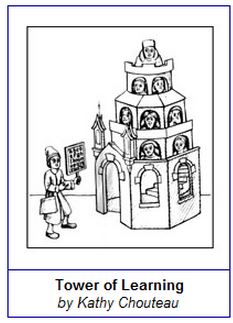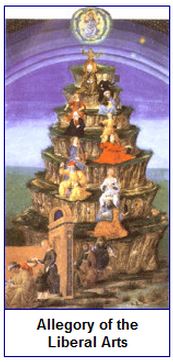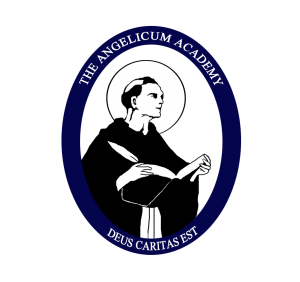 THE SEVERAL-STORIED TOWER by John Senior
THE SEVERAL-STORIED TOWER by John Senior
There is a well-known distinction, often cited and seldom seen, between the horizontal extension of knowledge and the vertical ascent to higher planes. For example, it is obvious that a knowledge of carpentry can be extended horizontally in the practice of the craft a man can learn more and more by
simply doing a certain thing again and again, say laying a floor; and his knowledge can also be extended by the application of this skill to different things from floors to staircases, windows, roofs. He will have learned by practice and application more and more about the same operations.
Now consider the knowledge of the architect which includes carpentry, not in its practice, but its reasons. The architect, in considering the principles of building as a whole, must know the reasons why that is, the difference between knowing how and knowing why. All the knowledge of all carpenters indefinetly extended will never add up to the least of architects, and the least of architects, though he has not the skill to do it, understands the reasons why of carpentry beyond the carpenter himself. The architect from a higher prospect sees the reasons for what carpenters, masons, tilers, glaziers do. He sees the reasons for those things and integrates them he doesn’t simply coordinate, that is, order disparate lines of activity the way a foreman does; he integrates them, that is, he sees them as parts of an integer, or whole. Floor, staircase, window, roof are not co-ordinates, but parts which together make up the house; they are constitutive elements of the thing, the one, whole, integral thing. But suppose all knowledge is an integer!
There is a famous picture coming down to us in different versions from the Middle Ages, illustrating education. It depicts versions a several-stories tower into which the schoolboy with his satchel and his tablet enters on the ground floor, greeted by the stern magister, who has merry eyes, a big stick called a baculum and a book called the Donatus from its author, the fourth-century grammarian. Next, the window of the second storey, we seethe boy progress to Aristotle’s Logic and at the third window up to Cicero’s Rhetoric.
Suppose we pause here a moment to recapitulate and keep the point in mind: Rhetoric is the liberal art of intellectual nourishment, as cooking is the servile art of physical nourishment. Rhetoric makes the truth effective. It is not simply more and more grammar or more and more logic, any more than cooking is more and growing vegetables. Rhetoric is rather making something out of the sentences and the arguments that grammar and logic have supplied. Rhetoric is grammar and logic; they are its constitutive parts. From the point of view of the higher prospect of rhetoric, one looks down on grammar and logic and sees the reasons for their operations.
 These liberal arts differ from one another vertically; you rise from one to another vertically; you rise from one to the other, not by a horizontal extension, but a vertical ascent to a different level of understanding which includes the lower ones, analogous to the relation of part to whole.
These liberal arts differ from one another vertically; you rise from one to another vertically; you rise from one to the other, not by a horizontal extension, but a vertical ascent to a different level of understanding which includes the lower ones, analogous to the relation of part to whole.
In the picture, the boy, grown up to adolescence, climbs from the fourth to the seventh window, entering the higher storey’s of arithmetic, geometry, music, and astronomy, beyond which the young man climbs higher still, up to philosophy, comprising physics, biology, psychology, ethics, economics, politics to metaphysics and the highest peak, theology, the study of the mind of God who knows and made all things in Whom, therefore, the universe and all knowledge is integral.
The brave young man at the top of the stairs must now descend to wherever in the scale of work his talents lie, learning how to do one thing in the daily practice of an art or craft, but having had a vision of its place in the universal scheme of things in which architects cannot be arrogant nor carpenters envious because they both are parts of something greater than themselves. That is the difference between a technical school and a university the university rises to the universal; it integrates the horizontal in the vertical; it is a place where “young men see visions and old men dream dreams.”
And if your education has not been much like that, that is because no institution ever lives up to its purpose but at least some of us have tried.
Teaching, Plato says, is a species of friendship, whose highest degree is love, in which persons see each other as integral parts of something greater than themselves, a marriage, a family, a college, a nation, a faith.
In your education, past and future, in the pursuit of happiness, in marriage, friendship, in vocations, recreation, politics and just plain jobs, if you can find them in the long run, you will have to ask what the whole thing is: What are all those activities and commitments parts of? What is the integer? If you forget everything you learned at college most of it you will remember at least this question it will be on the very final examination which your own conscience will make at the last hour of your life: In your pursuit of horizons, of horizontal things, have you failed to raise your ryes and mind and heart up to the stars to the reasons for things, and beyond, as the great poet Dante says at the top of the tower of his poem:

